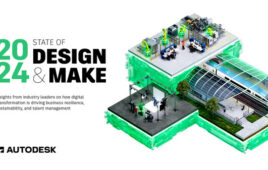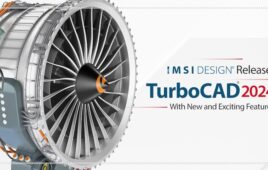Opera combines the Multi-Physics tool chain for modeling, simulation, analysis, and optimization of electronic related equipment with the advanced supercomputing magnet design and material know-how in Cobham Technical Services’ supercomputing quench solver.

This screen shot shows mosaic meshing of a superconducting magnet employing hexahedral, prism, pyramid, and tetrahedral elements.
Cobham Technical Services announced it developed powerful new modeling tools, which increase the accuracy and speed of Multi-Physics finite element simulations for developing superconducting magnets. These advances are helping a world leader in superconducting magnet systems for equipment such as nuclear magnetic resonance (NMR) scanners with a highly automated means of designing and optimizing nuclear magnetic resonance (NMR) scanners.
The advanced FEM algorithms and other tools were developed as part of the company’s role in the UK’s Integrated Modeling Package for Designing Advanced HTS Materials Application (MPDAHMA) project. It is partially funded by the UK government’s Technology Strategy Board and was led by superconducting magnet supplier Oxford Instruments whose aim was to combine the two separate steps of design and modeling into one function.

Here is a helical region meshed using hexahedral elements.
Three organizations collaborated in IMPDAHMA: Oxford Instruments NanoScience, Cobham Technical Services, and The Institute of Cryogenics at Southampton University. Leading the project, Oxford Instruments was responsible for manufacturing and testing sample magnets that included high temperature superconductor (HTS) materials and measuring material properties of composites. Southampton’s role was to obtain very precise measurements of the constituent materials at cryogenic temperatures – a crucial element for getting accurate simulation results and to validate the environment for Oxford Instruments’ tests. Cobham’s task was to expand its existing low temperature superconductor (LTS) simulation tools to include both LTS and HTS materials, while improving performance and accuracy.
The tools combine the advanced superconducting magnet design and material know-how represented in Oxford Instruments’ Magnet Design Database with the superconducting ‘quench’ solver in Cobham Technical Services’ Multi-Physics Opera tool chain for the modeling, simulation, analysis, and optimization of electromagnetic related equipment.
Understanding the quenching process – a rapid, highly non-linear and potentially dangerous change of state from superconducting to resistive mode – is critical for this design area. Accurate quench simulation depends on a complete specification of the wires, coils, materials, and protection circuits used in the magnetic system.
Cobham Technical Services’ work during the project resulted in three major new capabilities for Oxford Instruments. The most fundamental advance is in the FEM algorithms that divide a 3D computer design model of a magnet down into smaller connected elements to allow numerical solution. Models can now be meshed using a ‘mosaic’ mixture of prism, hexahedral, and pyramidal element shapes (as well as the tetrahedral elements that were available previously), to increase the accuracy of the simulation solution. This mosaic meshing also increases the speed of the subsequent coupled multi-physics transient thermal and eddy-current simulations. Assembling the non-linear thermal equations at each step is much more efficient, and eddy-current skin effect in conducting transformers can be captured with fewer elements. The transient thermal and electromagnetic simulations were also configured so that they can run in parallel on different processors to further increase speed of execution.

This is an Oxford Instrument test coil.
Cobham Technical Services also greatly expanded Opera’s electrical circuit modeling capability, and included a new graphical interface, which describes the power, drive, and protection circuitry that is essential to superconducting magnet operation (and current dissipation when a magnet goes into quench). And the company provided a direct link to Oxford Instruments’ materials database, which represents the complex non-linear properties of superconducting materials. A new materials database structure that will be integrated into a future version of Opera was developed to hold the wealth of materials information created in the project. However, this database can hold materials data for many other electromagnetic design applications.
The new Integrated Modeling Environment that came from the IMPDAHMA work has been validated by The Institute of Cryogenics. Oxford Instruments conducted tests on two high-field NMR systems used for validation. A 20 Tesla magnet with LTS coils was used initially, and an LTS magnet with additional HTS coil inserts (potentially capable of achieving a field of up to 25 Tesla) was used as new software tools and materials data became available. The tests showed very encouraging agreement between actual measurements and calculated values.
Dr. Ziad Melhem, IMPDAHMA Project Manager at Oxford Instruments said, “The IMPDAHMA work is helping to accelerate the exploitation of HTS materials in innovative magnet applications. As HTS materials properties and manufacturing processes continue to be improved, there will be scope for even higher magnetic fields.”
“Our quench solver has been one of the leading tools for superconducting magnet design for some years, and this work has allowed us to take several major steps forward,” said Chris Riley of Cobham Technical Services. “The intellectual property that has come out of this collaboration with these organizations is now being incorporated into new versions of the commercial Opera simulator.”
Professor Yifeng Yang of The Institute of Cryogenics added, “The real-world measurement validation performed by The Institute of Cryogenics was an important intermediate stage in this project, for both the software and hardware developers.” The new version of the Opera package that will incorporate most of these new resources will be released before the end of 2010.
Cobham Technical Services
www.cobham.com
Oxford University
www.oxinst.com
Institute of Crygenics at Southampton University
www.soton.ac.uk
Filed Under: Software • FEA, Software • simulation, ENGINEERING SOFTWARE, TEST & MEASUREMENT





Tell Us What You Think!